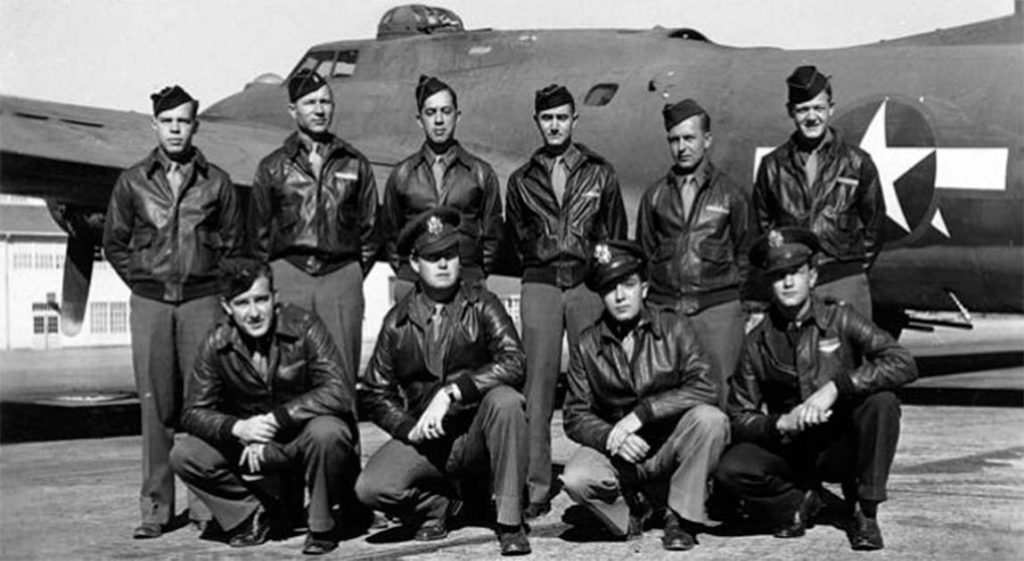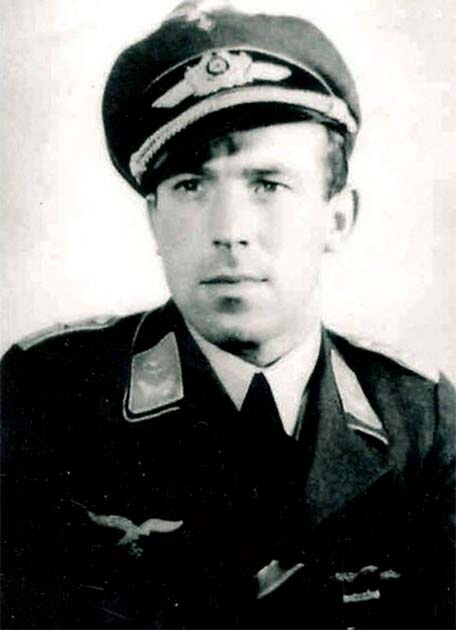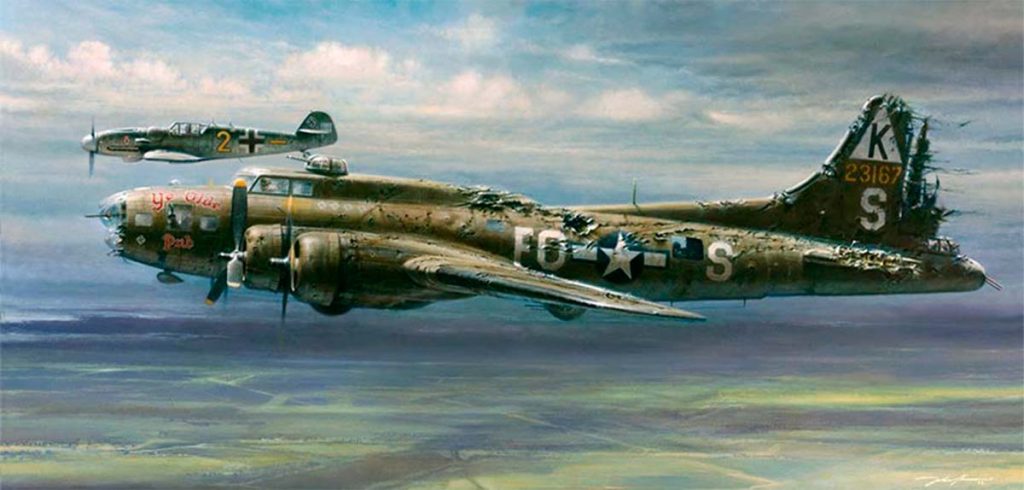War is often characterized by acts of violence and destruction, leaving little room for compassion or mercy. Yet, in the midst of the chaos, there are those who choose to show empathy and kindness towards their fellow man.
Franz Stigler, a German fighter pilot during World War II, was one such individual. Despite being ordered to shoot down a damaged American bomber, Stigler made the bold decision to spare the lives of the crew. His act of mercy has since become a remarkable example of humanity in the midst of war, reminding us of the power of compassion even in the darkest of times.
A Moment of Empathy
Franz Stigler was born in Regensburg, Bavaria on 21 August 1915. His father had been a pilot during WWI and Stigler learned to fly gliders when he was just 12 years old. By 1933 he was piloting biplanes and was flying for Deutsche Lufthansa in the run-up to WWII.
At the beginning of the war, Stigler joined the Luftwaffe as an instructor pilot (one of his top students, Gerhard Barkhorn, went on to shoot down over three hundred planes) before becoming a combat pilot himself. Stigler downed an impressive twenty-eight places in combat, earning him the title of fighter ace. But this impressive record isn’t what he is remembered for today.
Stigler became famous for saving lives, not taking them. On 20 December 1943, the crew of the Ye Olde Pub, an allied B-17F Flying Fortress was tasked with hitting an aircraft production factory in Bremen.

The crew, led by Charles (Charlie) Brown, had been warned it would be a dangerous mission prior to takeoff. It was likely they and their fellow bombers would run into hundreds of German fighters and the factory itself was protected by more than 250 flak guns.
The bomber was flying at 8,320m (27,300 ft) when just as it was about to commence its bombing run its plexiglass nose was shattered by flak. Its #2 engine was also completely destroyed, and its #4 engine was severely damaged. This damage meant that the plane had to reduce its speed, making it fall out of formation. Left behind as a straggler, the mighty plane became a sitting duck.
The target was too good to pass up and over a dozen German fighters swarmed the flying fortress for more than ten minutes. Unsurprisingly, the plane was badly damaged. Its #3 engine was completely knocked out, leaving the plane at half power (more like 40%) and its internal oxygen hydraulic and electrical systems were all also irreparably damaged.
- Amelia Earhart’s Last Flight – Mystery at Sea
- Operation Aphrodite: A Suicide Mission led by a Kennedy?
Not only was the plane now flying much slower than usual, but it was also increasingly difficult to maneuver. It had lost half its rudder and port elevator and its nose cone. Even worse, it could barely defend itself. Several of its guns had either jammed or been destroyed, meaning of its 11 guns, only 3 were still functioning.
The crew wasn’t faring much better. The plane’s tail gunner, Eckenrode, had been decapitated by a cannon shell, another had been hit by shrapnel in the leg, one had lost an eye, one had been hit in the shoulder and another’s feet had frozen. First aid had been made complicated by the fact the plane’s supply of morphine, which would have been handy, had also frozen.
The crew considered bailing out but decided against it after realizing at least one of them would never survive a parachute landing. Unable to radio for help, the brave crew decided to fly on and try to reach allied airspace. Unbeknownst to them, a guardian angel was coming to help them.
The Intervention
As the crippled bomber was trying to get home it flew over a German airfield, where it was spotted by several German pilots. One of them was Franz Stigler.
Stigler quickly jumped in his Messerschmitt BF 109 G-6, which was being refueled and rearmed at the time, and raced to catch up with the wounded plane. As he did so he saw through the many openings in the B-17 F’s fuselage that the plane was in bad shape. He could see multiple wounded airmen and the fact that the plane was barely airworthy.
As Stigler approached the plane its crew readied themselves for being shot down but much to their surprise, Stigler did not open fire. During his time fighting in North Africa Stigler had been told by his commanding officer, Gustav Rodel, “If I ever see or hear of you shooting at a man in a parachute, I will shoot you myself.” As Stigler saw it, the crew of the B-17F were no better off, he could not shoot them down.

Stigler tried to persuade Brown to land his plane at the nearby German airfield, or failing that, to divert to neutral Sweden. Unfortunately, Brown and his crew had no idea what the German was trying to say and continued flying home.
Stigler knew that the plane was in danger of being shot down by German anti-aircraft guns on the ground, so he decided to risk his own life. He flew near Brown’s plane in close formation so that his allies on the ground would not attempt to shoot the plane down.
He escorted the B-17F across the coast until it hit open water. At this point, Brown, who still didn’t know what Stigler was up to, ordered his tail gunner to target Stigler. If Stigler opened fire on them, his tail gunner was to shred the German plane. Stigler got the message and backed off, sure that the bomber was safe and out of German airspace.
Amazingly, all of the crew bar one survived. The plane managed to fly the remaining 250 miles (400km) across the north sea and landed at RAF Seething. Brown reported Stigler’s actions to his commanding officers but was ordered to keep quiet.
Was He Commended?
Certainly not at the time. Brown’s commanders feared that his story could cause the build-up of positive sentiment towards enemy pilots and were worried other damaged bombers would come to expect similar mercies from the enemy. As Brown put it, “Someone decided you can’t be human and be flying in a German cockpit.”
Stigler on the other hand, definitely kept quiet. He didn’t mention what he’d done to anyone. As a German pilot who had not just spared an enemy, but arguably aided them, he risked a court-martial.
Long after the war ended Brown was asked to be a guest speaker at a combat pilot reunion event, a “Gathering of the Eagles”. He was asked what his most memorable mission had been and recounted his story of the merciful German pilot. The speech inspired him to track down Stigler.
After four years of fruitless inquiries, Brown eventually received a letter from Stigler (now living in Canada) which simply read “I was the one.” Shortly afterward the two shared a phone call in which Stigler proved he was indeed Brown’s guardian angel. The two men became good friends and remained close until their deaths in 2008.

In 1993 Stigler was given the “Star of Peace” by the Combatants Federation of Europe in recognition of his heroics.
Franz Stigler’s act of mercy towards his fellow man is a shining example of compassion and humanity amidst the chaos of war. Despite the pressure to follow orders and prioritize his allegiance to his country, Stigler chose to listen to his conscience and spare the lives of the American bomber crew.
His bravery and selflessness in the face of danger is a reminder that even in the most trying of circumstances, we have the power to make a difference and show kindness to those around us. Stigler’s story is a testament to the importance of empathy and compassion, and his legacy will continue to inspire others to choose mercy over hate, even in the midst of the most brutal conflicts.
Top Image: Franz Stigler’s moment of mercy. Source: Nicolas Trudgian / Public Domain.